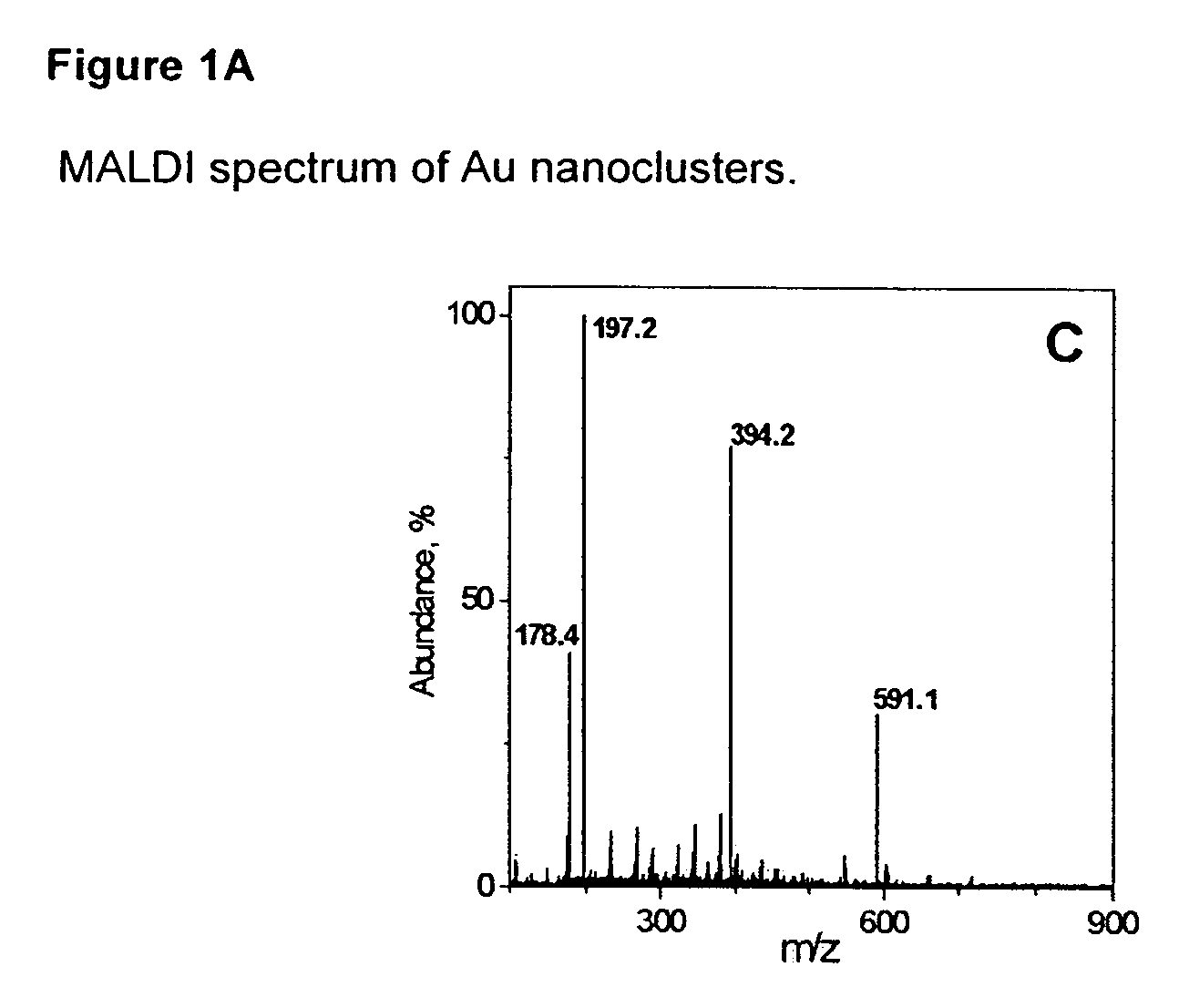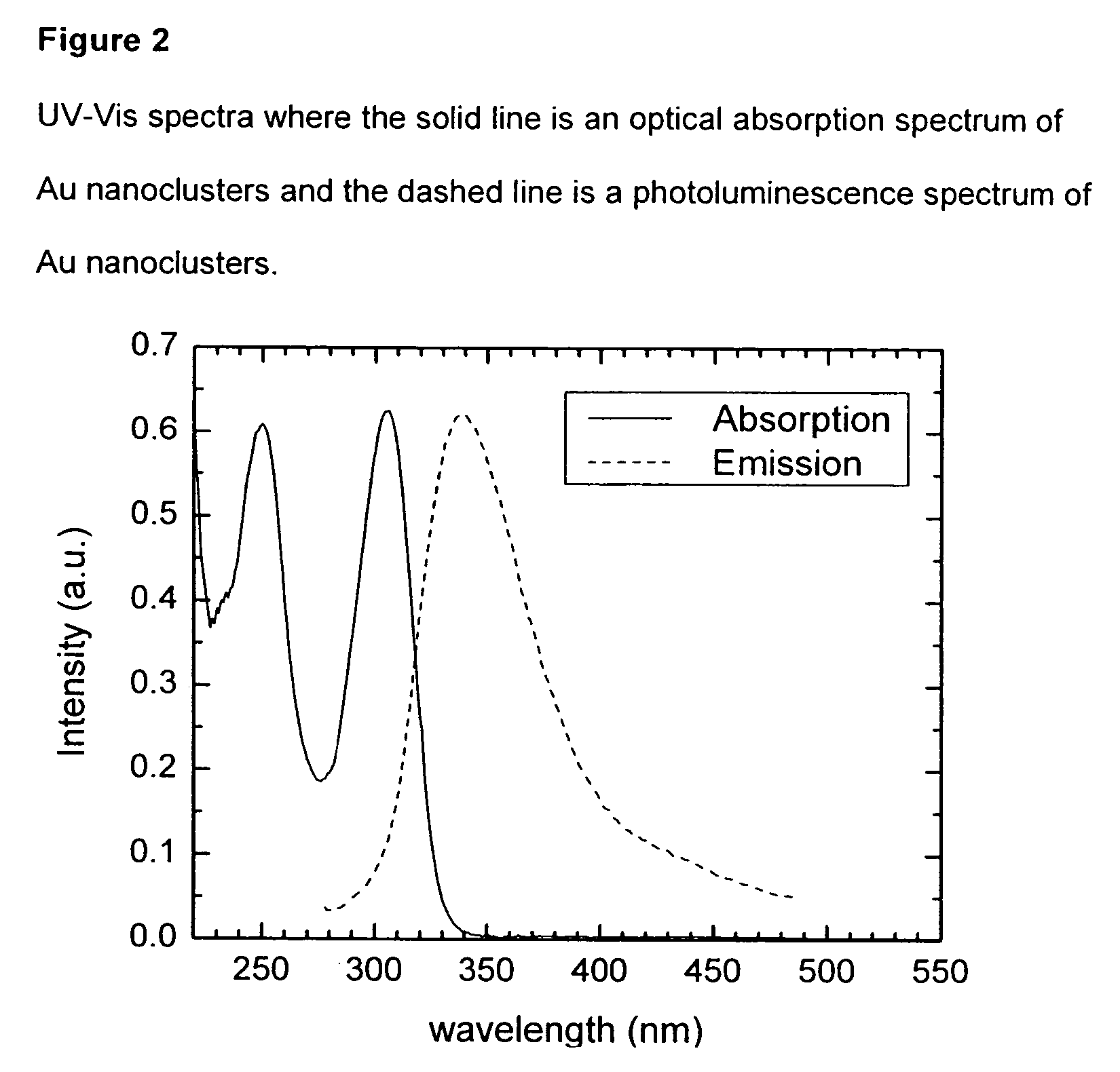Synthesis of ordered arrays from gold clusters
a technology of ordered arrays and gold clusters, applied in the direction of heat inorganic powder coating, coating, transportation and packaging, etc., can solve the problems of difficult chemically functionalization and short-lived phase clusters
- Summary
- Abstract
- Description
- Claims
- Application Information
AI Technical Summary
Benefits of technology
Problems solved by technology
Method used
Image
Examples
example 1
Synthesis of Gold Nanoclusters
[0058] AuCl3 (30 mg, 0.1 mmol) and dodecyldimethylammonian bromide (DDAB, 90 mg, 0.2 mmol) were mixed with 10 ml anhydrous toluene under inert gas (e.g. N2) in a 25 ml tri-neck flask. The solution was sonicated for ˜15 minutes in order to dissolve the AuCl3. The reaction system was purged with dry nitrogen for ˜30 minutes while stirring. Next a solution of aqueous NaBH4 (40 μL, 9.0 M, freshly prepared) was injected into the solution of AuCl3, while stirring vigorously. After stirring this mixture for ˜15 minutes, 1-dodecanethiol (0.8 ml) was added in a dropwise fashion via syringe, to produce a gold colloid. The gold colloid was precipitated from this solution by adding 20 ml of ethanol and allowing the solution to stand for ˜30 minutes to provide gold nanoparticles. The mixture was centrifuged and the supernatant was discarded.
[0059] The precipitated gold colloid (gold nanoparticles) was redispersed in a solution of dodecanethiol (2.0 ml) and octyl e...
example 2
Synthesis of an Ordered Array of Au Spheres
[0060] A solution of Au nanoclusters, as prepared in Example 1, was diluted with toluene to form a 1:2 toluene-diluted solution, and a portion (1 μl) was deposited on a substrate, in this case a carbon transmission electron microscopy (TEM) grid. The TEM grid was baked in ambient air (˜20° C.) on a TEM grid at 95° C. for 6 minutes, to provide the ordered array of Au spheres (size: 5.7±0.2 nm; lattice constant: 9.0±0.1 nm). See FIG. 4.
example 3
Synthesis of an Ordered Array of Au Cubes
[0061] A solution of Au nanoclusters, as prepared in Example 1, was diluted with toluene to form a 1:2 toluene-diluted solution, and a portion (1 μl) was deposited on a substrate, in this case a carbon transmission electron microscopy (TEM) grid. The TEM grid was baked in ambient air (˜20° C.) on a TEM grid at 105° C. for 6 minutes, to provide the ordered array of Au cubes (size: 10.4±0.6 nm; lattice constant: 11.4±0.2 nm). See FIG. 5A and FIG. 5B.
PUM
| Property | Measurement | Unit |
|---|---|---|
| size | aaaaa | aaaaa |
| size | aaaaa | aaaaa |
| width | aaaaa | aaaaa |
Abstract
Description
Claims
Application Information
 Login to View More
Login to View More - R&D
- Intellectual Property
- Life Sciences
- Materials
- Tech Scout
- Unparalleled Data Quality
- Higher Quality Content
- 60% Fewer Hallucinations
Browse by: Latest US Patents, China's latest patents, Technical Efficacy Thesaurus, Application Domain, Technology Topic, Popular Technical Reports.
© 2025 PatSnap. All rights reserved.Legal|Privacy policy|Modern Slavery Act Transparency Statement|Sitemap|About US| Contact US: help@patsnap.com



